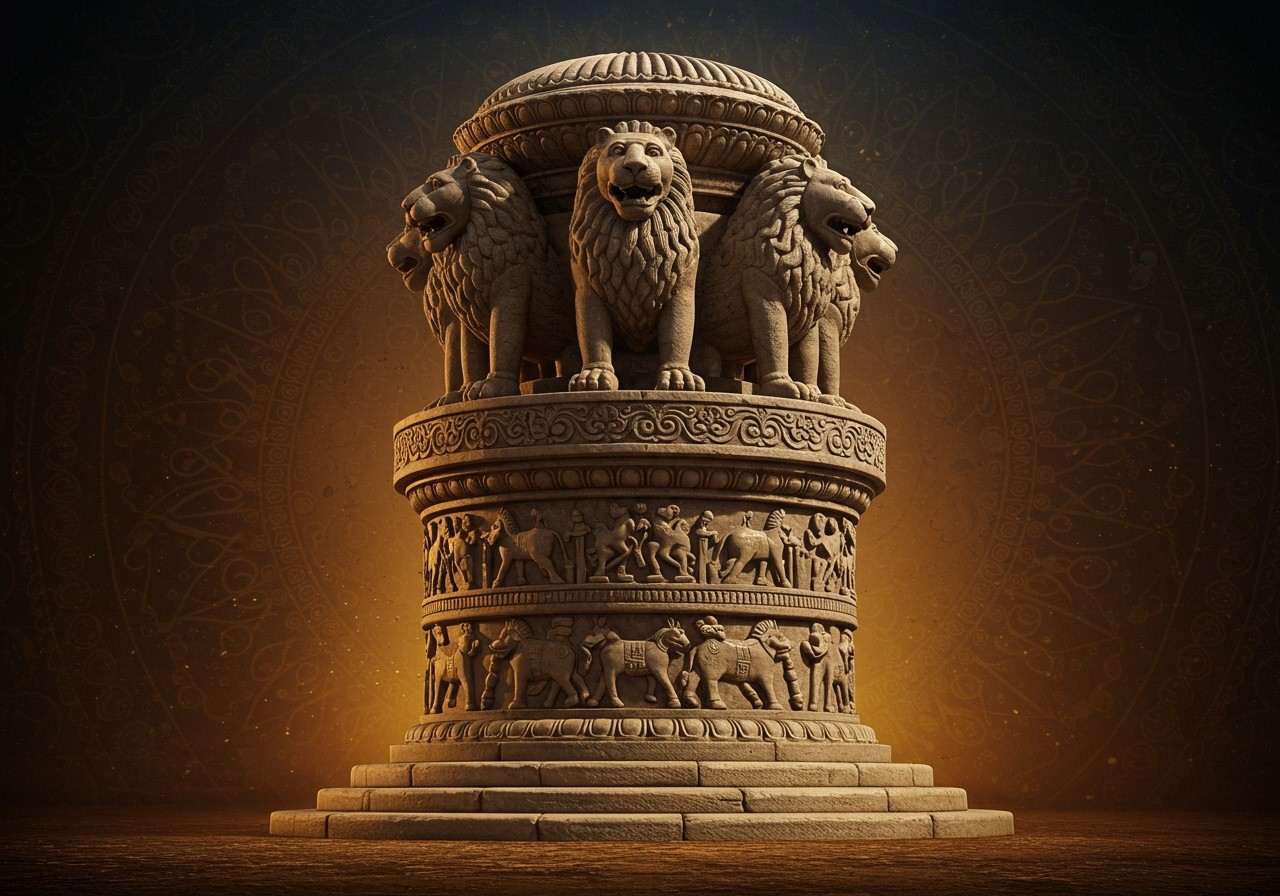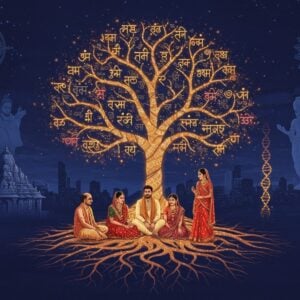
For every Indian, the sight of the four lions standing back-to-back is a moment of quiet pride. It’s a symbol etched into our hearts, seen on our currency, our passports, and our official documents. But the Lion Capital of Ashoka is much more than just a national emblem. It is a story in stone, a message from a great emperor that has echoed through centuries, speaking of strength, courage, peace, and dharma. Let’s take a journey together to understand the deep meaning behind this timeless symbol of India’s spirit.

A Journey Back in Time: The Story of the Sarnath Capital
To understand the Lion Capital, we must travel back to the 3rd century BCE, to the time of Emperor Ashoka of the Mauryan dynasty. After the brutal Kalinga War, a heartbroken Ashoka had a profound change of heart. He turned away from conquest and embraced Buddhism, dedicating his life to spreading the message of peace and righteousness. He erected magnificent pillars across his empire, and the one at Sarnath, near Varanasi, was crowned with this very capital. Sarnath was no ordinary place; it was the sacred ground where Lord Buddha gave his first sermon after attaining enlightenment. By placing the lions here, Ashoka was amplifying the Buddha’s message, sending the ‘roar of Dharma’ in all four directions.
A Masterpiece of Mauryan Artistry
The Lion Capital is a breathtaking example of ancient Indian craftsmanship. The skill of the Mauryan artists is visible in every detail. Let’s look at its beautiful components:
- The Four Lions: Four majestic lions are seated back-to-back, radiating power, courage, pride, and confidence. They are not roaring aggressively but have a calm, dignified expression, symbolizing a ruler who is powerful but governs with moral authority. They face the four cardinal directions, signifying the universal spread of Ashoka’s rule and the Buddha’s teachings.
- The Abacus: Below the lions is a circular drum, or abacus, which is a marvel of detailed carving. It features four animals—an elephant, a bull, a galloping horse, and a lion—separated by a beautifully depicted wheel, the Dharma Chakra. These animals are often interpreted as representing the four stages of Buddha’s life: his conception (the elephant), his youth (the bull), his departure from home (the horse), and his enlightenment (the lion).
- The Inverted Lotus: The entire structure rests on an inverted lotus flower, a powerful symbol in both Hindu and Buddhist traditions. The lotus represents purity and enlightenment, showing how one can rise above the murky waters of worldly desires to achieve spiritual awakening. The incredible polish on the sandstone, a hallmark of Mauryan art, still shines today, a testament to the genius of our ancestors. The principles of such ancient art can be further explored in the rich history of Hindu temple architecture.
The Heartbeat of a Nation: Our National Emblem
When India gained independence, our leaders chose the Lion Capital as the national emblem. It was a perfect choice, as it represents a new nation built on age-old principles of truth, justice, and courage. Below the emblem, the words “Satyameva Jayate” (Truth Alone Triumphs) are inscribed. This sacred phrase, taken from the Mundaka Upanishad, is the soul of our nation’s philosophy.
Every time we see this emblem, it’s a powerful reminder of our rich heritage and the values we stand for. It connects modern India to its glorious past and inspires us to build a future based on righteousness and unity.
Bringing a Piece of Heritage into Your Home
While we revere these powerful symbols in museums and on official documents, many of us feel a deep desire to bring a touch of this profound heritage into our own homes and sacred spaces. This connection to our roots gives us strength and peace in our busy modern lives. At poojn.in, we understand this heartfelt need to stay connected to our traditions.
We take great care in offering authentic culturally significant items that resonate with this rich legacy. If you wish to delve deeper into the philosophies that shaped symbols like the Lion Capital, you might find solace and wisdom in our collection of holy books. Our aim is to help you keep your traditions alive with convenience and authenticity.
For any assistance or to explore our offerings, you can always reach out to us at 03369029784 or send a message on WhatsApp at 9476142738. We are here to serve your cultural and spiritual needs.
Understanding the Ashoka Emblem: Common Questions Answered
Many of us have questions about this iconic symbol. For instance, what exactly is the Lion Capital of Ashoka? It is a magnificent sculpture, originally placed on top of an Ashoka Pillar in Sarnath, featuring four Asiatic lions seated back-to-back.
Its importance lies not just in its ancient origins but in its profound message. It symbolizes the triumph of dharma over force, representing power, courage, and confidence guided by moral principles. The emblem’s connection to Buddhism is very deep, as it was commissioned by Emperor Ashoka to spread the teachings of Lord Buddha after he adopted the faith.
For those who wish to see the original masterpiece, it is lovingly preserved and displayed at the Sarnath Museum, near Varanasi in India. When India became a sovereign nation, this emblem was chosen to represent the country’s values of peace, goodwill, and strength, reflecting the very ideals enshrined in our Constitution.
People often explore the iconography of Ashoka’s pillars to connect with the history, culture, and spiritual ethos of Ashoka’s reign. These pillars are not just historical artifacts; they are timeless lessons in moral governance and universal peace.
A Timeless Symbol of India’s Spirit
The Lion Capital of Ashoka is far more than an ancient relic; it is a living symbol of India’s enduring soul. Its beautiful artistry and deep meaning continue to inspire us. It tells a story of a great king’s transformation and a nation’s commitment to righteousness. As our national emblem, it stands as a proud beacon of unity, strength, and truth, beautifully bridging our ancient heritage with our modern identity and guiding us towards a future of peace and dharma.


